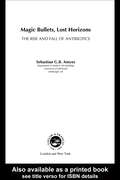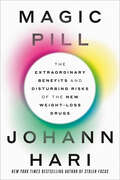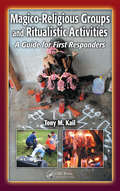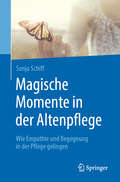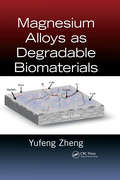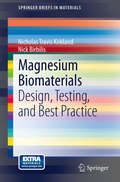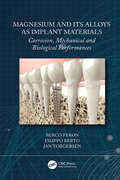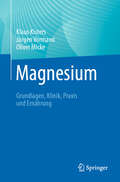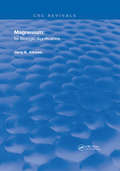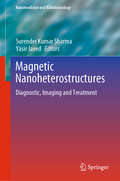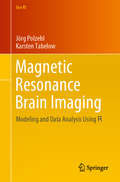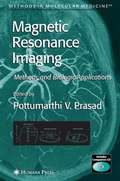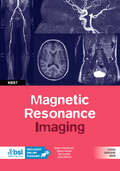- Table View
- List View
Madness: A Bipolar Life
by Marya HornbacherIn the vein of An Unquiet Mind comes a storm of a memoir that will take you deep inside bipolar disorder and change everything you know. When Marya Hornbacher published her first book, Wasted: A Memoir of Anorexia and Bulimia, she did not yet have the piece of shattering knowledge that would finally make sense of the chaos of her life. At age twenty-four, Hornbacher was diagnosed with Type I rapid-cycle bipolar, the most severe form of bipolar disorder. In Madness, in her trademark wry and utterly self-revealing voice, Hornbacher tells her new story. Through scenes of astonishing visceral and emotional power, she takes us inside her own desperate attempts to counteract violently careening mood swings by self-starvation, substance abuse, numbing sex, and self-mutilation. How Hornbacher fights her way up from a madness that all but destroys her, and what it is like to live in a difficult and sometimes beautiful life and marriage—where bipolar always beckons—is at the center of this brave and heart-stopping memoir.Madness delivers the revelation that Hornbacher is not alone: millions of people in America today are struggling with a variety of disorders that may disguise their bipolar disease. And Hornbacher's fiercely self-aware portrait of her own bipolar as early as age four will powerfully change, too, the current debate on whether bipolar in children actually exists. New York Times&“Humorous, articulate, and self-aware…A story that is almost impossible to put down.&”— &“With the same intimately revelatory and shocking emotional power that marked [Wasted], Hornbacher guides us through her labyrinth of psychological demons.&”—Elle
Madness: Race and Insanity in a Jim Crow Asylum
by Antonia HyltonIn the tradition of The Immortal Life of Henrietta Lacks, this New York Times bestseller is a page-turning account of one of the nation&’s last segregated asylums..."a book that left me breathless" (Clint Smith). For centuries, Black patients have been absent from our history books. Madness transports readers through the ninety-three-year history of Crownsville Hospital, one of the last segregated asylums with surviving records and a campus that still stands to this day in Anne Arundel County, Maryland. Antonia Hylton blends the intimate tales of patients and employees whose lives were shaped by Crownsville with a decade-worth of investigative research and archival documents. Madness chronicles the stories of Black families whose mental health suffered as they tried, and sometimes failed, to find safety and dignity. Hylton also grapples with her own family&’s experiences with mental illness, and the secrecy and shame that it reproduced for generations. As Crownsville Hospital grew from an antebellum-style work camp to a tiny city sitting on 1,500 acres, the institution became a microcosm of America&’s evolving battles over slavery, racial integration, and civil rights. Hylton traces the legacy of slavery to the treatment of Black people&’s bodies and minds in our current mental healthcare system. It is a captivating and heartbreaking meditation on how America decides who is sick or criminal, and who is worthy of our care or irredeemable.
Magic Bullets, Lost Horizons: The Rise and Fall of Antibiotics
by Sebastian G. AmyesFrom the day that Paul Ehrlich hailed his newly discovered treatment for syphilis as the magic bullet, antibiotics have transformed medical practice. They are considered one of the miracle drugs of the 20th century. However, the massive and increasing misuse of these agents is More...causing a problem of resistance that may prove to be one of the greatest threats to health in the 21st century. Magic Bullets, Lost Horizons aims to put some of the media sensationalism into perspective. It examines not only the development of modern antibiotics but also the obstacles faced during application of the drugs and their expected efficacy in the future.
Magic Bullets, Miracle Drugs, and Microbiologists: A History of the Microbiome and Metagenomics
by William C. SummersMagic Bullets, Miracle Drugs, and Microbiologists Magic Bullets, Miracle Drugs, and Microbiologists: A History of the Microbiome and Metagenomics by William C. Summers is an enlightening journey through the fascinating world of microbiology, exploring its history, challenges, and the revolutionary concept of the microbiome. Summers draws from his unique perspective as both a practicing microbiologist and a historian of science, influenced by early microbiological literature and his own extensive career, presenting how our understanding of microbes evolved from concepts of simple germs to complex, essential elements of life. Summers skillfully ties together key players and eras in the microbial sciences into a concise narrative, from early microscopic observations to the revolutionary developments in genetic analysis and metagenomics, highlighting our ever-evolving understanding of the diverse microbial world. Magic Bullets, Miracle Drugs, and Microbiologists is a compelling read for anyone interested in the profound impact of microorganisms on our world. “Bill Summers artfully explains how, over the past century, scientists have synthesized new disciplines and embraced evolving technologies to develop new concepts about how germs behave in microbial communities and what their relationship is to the environment, human health, and epidemic diseases. Skillfully written in engaging prose, this book will be valuable to microbiologists, epidemiologists, medical historians, and geneticists seeking to better understand the historic roots of twenty-first century microbiology.” — Powel H Kazanjian, University of Michigan Medical School and Author of Frederick Novy and the Development of Bacteriology in Medicine
Magic Pill: The Extraordinary Benefits and Disturbing Risks of the New Weight-Loss Drugs
by Johann HariThe bestselling author of Lost Connections and Stolen Focus offers a revelatory look at the new drugs transforming weight loss as we know it—from his personal experience on Ozempic to our ability to heal our society&’s dysfunctional relationship with food, weight, and our bodies.In January 2023, Johann Hari started to inject himself once a week with Ozempic, one of the new drugs that produces significant weight loss. He wasn&’t alone—some predictions suggest that in a few years, a quarter of the U.S. population will be taking these drugs. While around 80 percent of diets fail, someone taking one of the new drugs will lose up to a quarter of their body weight in six months. To the drugs&’ defenders, here is a moment of liberation from a condition that massively increases your chances of diabetes, cancer, and an early death. Still, Hari was wildly conflicted. Can these drugs really be as good as they sound? Are they a magic solution—or a magic trick? Finding the answer to this high-stakes question led him on a journey from Iceland to Minneapolis to Tokyo, and to interview the leading experts in the world on these questions. He found that along with the drug&’s massive benefits come twelve significant potential risks. He also found that these drugs radically challenge what we think we know about shame, willpower, and healing. What do they reveal about the nature of obesity itself? What psychological issues begin to emerge when our eating patterns are suddenly disrupted? Are the drugs a liberation or a further symptom of our deeply dysfunctional relationship with food? These drugs are about to change our world, for better and for worse. Everybody needs to understand how they work—scientifically, emotionally, and culturally. Magic Pill is an essential guide to the revolution that has already begun, and which one leading expert argues will be as transformative as the invention of the smartphone.
Magico-Religious Groups and Ritualistic Activities: A Guide for First Responders
by Tony M. KailMore than just a litany of artifacts, rituals, and symbols, this valuable book provides a cultural bridge for emergency responders. It places the information in a relevant context and offers crucial keys to communication, assessment, and treatment in culturally sensitive situations. Beginning with the importance of trans-cultural communication, the book separates fact from fantasy regarding Neo-Paganism, Santeria, Bantu religion (Palo Mayombe), Voodoo, and Curanderismo. Promoting functional cultural competency, this book provides the tools to properly assess situations, open lines of communication, protect cultural diversity, and provide effective emergency treatment.
Magische Momente in der Altenpflege: Wie Empathie und Begegnung in der Pflege gelingen
by Sonja SchiffAltenpflege ist Beziehungs- und Gefühlsarbeit. Sie erfordert Mut und Kompetenz, mit der Vergangenheit alter Menschen umzugehen, mit erlebtem Lebensglück ebenso wie mit Trauer und Verzweiflung. Bei vielen Pflegenden gibt es eine Sehnsucht nach Begegnungen mit alten Menschen. Trotzdem bleiben viele Kontakte, aus Unsicherheit oder Angst, an der Oberfläche. Eine wesentliche empathische Erfahrung geht damit verloren. Denn es können besondere Begegnungen entstehen, wenn Pflegepersonen es wagen, sich wirklich auf alte Menschen einzulassen. Genau diese magischen Momente sind es, die Altenpflege für viele Pflegende so spannend machen. Sie stärken die Berufszufriedenheit, geben Kraft für schwierige berufliche Zeiten und sind ein, bis dato völlig unterschätzter Grund, warum Pflegende im Beruf bleiben. Sonja Schiff erzählt ihre eigenen Schlüsselerlebnisse mit alten Menschen und lässt auch andere Personen - unterschiedliche Professionisten aus der Altenpflege- und Altenbetreuung - in Form von strukturierten Interviews zu Wort kommen. Es entstanden Geschichten, die die Leserin/den Leser tief berühren und Kraft geben. Gepaart mit einem leidenschaftlichen Plädoyer für eine dringende Weiterentwicklung der Altenpflege und Kritik am bestehenden System, geht sie auch der Frage nach, welchen Anteil Pflegepersonen selbst an der Erreichung eines magischen Moments haben und wie sie diese umsetzen können. Jedes Kapitel wird eingeleitet und mit Aufgaben beendet, die zum Ausprobieren motivieren. Ein "Mutmach-Buch" für alle Pflege- und Betreuungskräfte der Altenpflege. Es richtet sich aber auch an Führungskräfte von Altenpflegeeinrichtungen, Angehörige und sozialpolitisch tätige Personen.
Magnesium Alloys as Degradable Biomaterials
by Yufeng ZhengMagnesium Alloys as Degradable Biomaterials provides a comprehensive review of the biomedical applications of biodegradable magnesium and its alloys. Magnesium has seen increasing use in orthopedic and cardiovascular applications over the last decade, particularly for coronary stents and bone implants.The book discusses the basic concepts of biodeg
Magnesium Alloys for Biomedical Applications: Advances and Challenges
by Deepak Kumar Nooruddin AnsariMagnesium alloys have enormous potential for use in biomedical implants. Magnesium Alloys for Biomedical Applications delves into recent advances and prospects for implementation and provides scientific insights into current issues posed by Mg alloy materials. It provides an overview of research on their mechanical and tribological characteristics, corrosion tendencies, and biological characteristics, with a particular emphasis on biomedical implants. Details the fundamentals of Mg alloys as well as necessary surface modifications of Mg alloys for biomedical use. Discusses emerging Mg alloys and their composites. Covers mechanical, tribological, and chemical properties, as well as fatigue and corrosion. Highlights emerging manufacturing methods and advancements in new alloy design, composite manufacturing, unique structure design, surface modification, and recyclability. Helps readers identify appropriate Mg-based materials for their applications and select optimal improvement methods. Summarizes current challenges and suggests a roadmap for future research. Aimed at researchers in materials and biomedical engineering, this book explores the many breakthroughs achieved with these materials and where the field should concentrate to ensure the development of safe and reliable Mg alloy-based implants.
Magnesium Biomaterials
by Nicholas Travis Kirkland Nick BirbilisMagnesium Biomaterials provides a succinct up-to-date overview of Magnesium biomaterial development, critically examines the types of in vitro experiments that may be performed, and investigates the numerous variables that affect Magnesium biodegradation when undertaking these experiments. This work also discusses the direction in which current Magnesium biomaterial development is heading and the necessary steps for future development of this field. Information is drawn from numerous multi-disciplinary sources to provide a coherent and critical overview. Magnesium Biomaterials is ideal for researchers in the area of bio-Mg, companies interested in exploring their own alloys, and for researchers working with other biodegradable materials who are seeking a cross-platform understanding of material performance.
Magnesium and Its Alloys as Implant Materials: Corrosion, Mechanical and Biological Performances
by Mirco Peron Filippo Berto Jan TorgersenDespite their tremendous potential, Mg and its alloys are not yet used in biomedical applications. This book aims to provide scientific insights into the challenges of the materials, and give an overview of the research regarding their mechanical properties, corrosion behaviour and biological performances. The authors intend to put the reader into the position to accurate discern the proper Mg-based material for his/her applications and to choose the proper improvement strategy to his/her cause. To this aim, the manuscript is structured as follow: in Section 2, the main challenges hampering the use of magnesium in biomedical applications and the common improvement strategies are listed. In Section 3, the most investigated Mg alloys are reported in separate sub-sections, detailing their mechanical properties, corrosion behaviour and biotoxicity. High-pure and ultra-high-pure Mg, Al-based Mg alloys, Zn-based Mg alloys, Ca-based alloys and RE-based Mg alloys have been considered. In Section 4, the alloys’ performances with respect to the challenges is summarized providing the reader with useful information and suggestions on the potentially most suited choice. Finally, in Section 5, an outlook portraying the authors’ opinion of the future development of the field will be provided. This book will allow biomedical engineers, surface scientists, material scientists, implant manufacturers and companies working on implant approval an overview of the state-of-the-art technologies adopted so far to overcome the drawbacks of Mg for biomedical applications. Particular emphasis is put on explaining the link between mechanical, corrosion and biocompatible properties of Mg and its alloys as well as their pros and cons. In doing so, the authors intend to put the reader into the position to accurate discern the proper Mg-based material for his/her applications and to choose the proper improvement strategy to his/her cause.
Magnesium in Human Health and Disease
by Victor R. Preedy Ronald Ross Watson Sherma ZibadiMagnesium is an essential mineral which is required for growth and survival of humans. Since magnesium is a mineral and not synthesizable it must be obtained through dietary foods and/or supplements. Magnesium in Human Health and Disease reviews the benefits of magnesium supplementation to reach recommended intakes as well as provides new research that suggests how reaching levels above the recommended intakes can promote health and treat various diseases. Magnesium deficiency can cause low serum potassium and calcium levels, retention of sodium, and low circulating levels of regulatory hormones. These changes in nutrients cause neurological and muscular symptoms such as tremor and muscle spasms. Further magnesium deficiency causes loss of appetite, nausea, vomiting, personality changes and death from heart failure. Causes of magnesium deficiency include alcohol abuse, poorly controlled diabetes, excessive or chronic vomiting and/or diarrhea. Thus the effects of inadequate and deficient intakes or levels of magnesium is critical to health and are reviewed by the expert clinicians in this book. Magnesium in Human Health and Disease provides the most current research to support the potential benefits or lack thereof for normal and high supplementation with magnesium. Animal model research and early human trials are reviewed to document other disease states such as hypertension, cholesterol level, type 2 diabetes and cardiovascular disease that would benefit from increased magnesium.
Magnesium: Applications in Clinical Medicine
by Erine A. Kupetsky D. O.Magnesium is an essential mineral required by humans, playing an important role in multiple biochemical processes as well as preventing and managing several diseases and disorders. Deficiencies of magnesium can lead to a wide range of medical conditions, including cardiovascular disease, diabetes, and hypertension. <P><P>With myocardial infarction and stroke being the first and fifth cause of mortality in the United States, the pharmaceutical industry has been trying to produce therapies that reduce co-morbidity and mortality. Recent observational studies of magnesium have added to the list of potential therapeutic modalities that have been proven useful in reducing hypertension, stroke sequalae, metabolic syndrome/dyslipidemia, and inflammatory diseases. Magnesium therapeutic modalities also have impacts in the fields of neurology, the elderly, and in obstetrics. <P><P>Magnesium: Applications in Clinical Medicine explores the many uses of magnesium and its applications in clinical medicine. <P><P>Features: <li>Presents information on the impacts magnesium has on various aspects of health conditions and disease prevention. <li>Describes magnesium usage in treating and managing several conditions including dyslipidemia, migraine, metabolic syndrome, and high blood pressure. <li>Discusses magnesium therapy in stroke and magnesium deficiency in attention deficit hyperactivity disorder. <li>Promotes knowledge of overall health and wellness that can be applied in any specialty of medicine. <P><P>This book encompasses various uses of magnesium in a clinical setting ranging from its role in maintaining homeostasis, to its uses in the fields of dermatology, cardiology, neurology, and in obstetrics. Written by contributors who are experts in their fields, it is a comprehensive collaboration of this ubiquitous dietary supplement’s applications in clinical medicine.
Magnesium: Grundlagen, Klinik, Praxis und Ernährung
by Klaus Kisters Jürgen Vormann Oliver MickeMagnesium ist ein essentieller Mineralstoff, der für das Wachstum und Überleben benötigt wird. Als essentieller Mineralstoff kann er nicht synthetisiert werden und muss über die Ernährung und/oder Nahrungsergänzungsmittel aufgenommen werden. Das Buch gibt einen Überblick zu den Grundlagen des Magnesiumstoffwechsels, Aufgaben und Funktionen von Magnesium, Magnesiumhaushalt, Magnesiumbedarf und Referenzwerte, Mangelsymptome, Möglichkeiten der Versorgung durch richtige Ernährung und Magnesiumpräparate. Ferner diskutiert es die Vorteile einer ausreichenden Magnesiumzufuhr bei verschiedenen Krankheiten und zur Gesundheitsprävention. Ein Magnesiummangel führt beispielsweise zu neurologischen und muskulären Symptomen. Aber auch bei Depressionen oder der Demenz spielt Magnesium eine wichtige Rolle. Zu den Ursachen für Magnesiummangel gehören Alkoholmissbrauch, schlecht eingestellter Diabetes, übermäßiges oder chronisches Erbrechen und/oder Durchfall. Aber auch Arzneimittelinteraktionen mit bestimmten Medikamenten, wie z.B. zur Blutdrucksenkung können einen Magnesiummangel provozieren. Abschließend gehen die Autoren auf die Besonderheiten des Zusammenhangs der Magnesiumaufnahme mit einer ausreichenden Vitamin D Versorgung ein. Das Buch richtet sich an Ärzte, Pharmakologen, Studenten, Ernährungswissenschaftler, Diätologen und andere Ernährungsfachleute, die mehr über diesen wichtigen Mineralstoff und seinen Beitrag zur Gesundheitsversorgung erfahren möchten.
Magnesium: It's Biologic Significance (Routledge Revivals)
by Jerry K. AikawaFirst Published in 1981, this book offers a full, comprehensive guide into the aspects of magnesium and its effect on our bodies, ecosystem, and much more. Carefully compiled and filled with a vast repertoire of notes and references this book is a useful reference for Dieticians, Physicians, and Students in their respective fields.
Magnetic Nanoheterostructures: Diagnostic, Imaging and Treatment (Nanomedicine and Nanotoxicology)
by Surender Kumar Sharma Yasir JavedThis book contains most updated information on synthesis of magnetic nanohybrids, their physio-chemical properties, and key biological applications. It highlights the complexity of nanoheterostructures, especially magnetic metal oxides, ferrites and doped magnetic nanomaterials, and discusses their potential applications in the early detection, imaging and treatment of cancer. It also covers the toxicity and risk assessment of multifunctional nanomaterials. Providing an overview of magnetic nanoheterostructures, it appeals to a wide audience, from beginners and graduate-level students to experts in academia and industry.
Magnetic Nanoparticles: A New Platform for Drug Delivery (Gels Horizons: From Science to Smart Materials)
by Vijay Kumar Thakur K. S. Joshy Thomas SabuThis volume covers current research in the usage of magnetic nanoparticles for drug delivery. It discusses synthesis methods, stabilizers used for surface coating on MNPs, and potential target ligands which can be used to ferry payloads to the targeted disease region. It also highlights the factors affecting delivery efficiency and toxicity, as well as the different routes of administration. The content also focus on the use of these carriers for gene therapy and to target brain tumors. This volume will be of interest to researchers working on drug discovery and delivery platforms.
Magnetic Resonance Angiography
by James C. Carr Timothy J. CarrollMagnetic Resonance Angiography: Principles and Applications is a comprehensive text covering magnetic resonance angiography (MRA) in current clinical use. The first part of the book focuses on techniques, with chapters on contrast-enhanced MRA, time of flight, phase contrast, time-resolved angiography, and coronary MRA, as well as several chapters devoted to new non-contrast MRA techniques. Additionally, chapters describe in detail specific topics such as high-field MRA, susceptibility-weighted imaging, acceleration strategies such as parallel imaging, vessel wall imaging, targeted contrast agents, and low dose contrast-enhanced MRA. The second part of the book covers clinical applications of MRA, with each chapter describing the MRA techniques and protocols for a particular disease and vascular territory, as well as the pathology and imaging findings relevant to the disease state being discussed. Magnetic Resonance Angiography: Principles and Applications is designed to bring together into a single textbook all of the MRA techniques in clinical practice today and will be a valuable resource for practicing radiologists and other physicians involved in the diagnosis and treatment of vascular diseases, as well as biomedical physicists, MRI technologists, residents, and fellows. Editors James C. Carr, MD, is the Director of Cardiovascular Imaging and Associate Professor of Radiology and Medicine at Northwestern University Feinberg School of Medicine, Chicago, Illinois, USA. Timothy J. Carroll, PhD, is the Director of MRI Research and Associate Professor in the Departments of Biomedical Engineering and Radiology at Northwestern University, Evanston, Illinois, USA. Magnetic Resonance Angiography: Principles and Applications is designed to bring together into a single textbook all of the MRA techniques in clinical practice today and will be a valuable resource for practicing radiologists and other physicians involved in the diagnosis and treatment of vascular diseases, as well as biomedical physicists, MRI technologists, residents, and fellows. Editors James C. Carr, MD, is Director of Cardiovascular Imaging and Associate Professor of Radiology and Medicine at Northwestern University Feinberg School of Medicine, Chicago, Illinois, USA. Timothy J. Carroll, PhD, is Assistant Professor in the Department of Radiology at Northwestern University Feinberg School of Medicine, Chicago, Illinois, USA. Editors James C. Carr, MD, is Director of Cardiovascular Imaging and Associate Professor of Radiology and Medicine at Northwestern University Feinberg School of Medicine, Chicago, Illinois, USA. Timothy J. Carroll, PhD, is the Director of MRI Research and Associate Professor in the Departments of Biomedical Engineering and Radiology at Northwestern University, Evanston, Illinois, USA.
Magnetic Resonance Brain Imaging: Modeling and Data Analysis Using R (Use R!)
by Jörg Polzehl Karsten TabelowThis book discusses the modeling and analysis of magnetic resonance imaging (MRI) data acquired from the human brain. The data processing pipelines described rely on R. The book is intended for readers from two communities: Statisticians who are interested in neuroimaging and looking for an introduction to the acquired data and typical scientific problems in the field; and neuroimaging students wanting to learn about the statistical modeling and analysis of MRI data. Offering a practical introduction to the field, the book focuses on those problems in data analysis for which implementations within R are available. It also includes fully worked examples and as such serves as a tutorial on MRI analysis with R, from which the readers can derive their own data processing scripts. The book starts with a short introduction to MRI and then examines the process of reading and writing common neuroimaging data formats to and from the R session. The main chapters cover three common MR imaging modalities and their data modeling and analysis problems: functional MRI, diffusion MRI, and Multi-Parameter Mapping. The book concludes with extended appendices providing details of the non-parametric statistics used and the resources for R and MRI data.The book also addresses the issues of reproducibility and topics like data organization and description, as well as open data and open science. It relies solely on a dynamic report generation with knitr and uses neuroimaging data publicly available in data repositories. The PDF was created executing the R code in the chunks and then running LaTeX, which means that almost all figures, numbers, and results were generated while producing the PDF from the sources.
Magnetic Resonance Brain Imaging: Modelling and Data Analysis Using R (Use R!)
by Jörg Polzehl Karsten TabelowThis book discusses modelling and analysis of Magnetic Resonance Imaging (MRI) data of the human brain. For the data processing pipelines we rely on R, the software environment for statistical computing and graphics. The book is intended for readers from two communities: Statisticians, who are interested in neuroimaging and look for an introduction to the acquired data and typical scientific problems in the field and neuroimaging students, who want to learn about the statistical modeling and analysis of MRI data. Being a practical introduction, the book focuses on those problems in data analysis for which implementations within R are available. By providing full worked-out examples the book thus serves as a tutorial for MRI analysis with R, from which the reader can derive its own data processing scripts.The book starts with a short introduction into MRI. The next chapter considers the process of reading and writing common neuroimaging data formats to and from the R session. The main chapters then cover four common MR imaging modalities and their data modeling and analysis problems: functional MRI, diffusion MRI, Multi-Parameter Mapping and Inversion Recovery MRI. The book concludes with extended Appendices on details of the utilize non-parametric statistics and on resources for R and MRI data.The book also addresses the issues of reproducibility and topics like data organization and description, open data and open science. It completely relies on a dynamic report generation with knitr: The books R-code and intermediate results are available for reproducibility of the examples.
Magnetic Resonance Elastography
by Sudhakar K. Venkatesh Richard L. EhmanThe first book to cover the groundbreaking development and clinical applications of Magnetic Resonance Elastography, this book is essential for all practitioners interested in this revolutionary diagnostic modality. The book is divided into three sections. The first covers the history of MRE. The second covers technique and clinical applications of MRE in the liver with respect to fibrosis, liver masses, and other diseases. Case descriptions are presented to give the reader a hands-on approach. The final section presents the techniques, sequence and preliminary results of applications in other areas of the body including muscle, brain, lung, heart, and breast.
Magnetic Resonance Imaging
by E. Mark Haacke Robert W. Brown Ramesh Venkatesan Y.-C. Norman Cheng Michael R. ThompsonNew edition explores contemporary MRI principles and practicesThoroughly revised, updated and expanded, the second edition of Magnetic Resonance Imaging: Physical Principles and Sequence Design remains the preeminent text in its field. Using consistent nomenclature and mathematical notations throughout all the chapters, this new edition carefully explains the physical principles of magnetic resonance imaging design and implementation. In addition, detailed figures and MR images enable readers to better grasp core concepts, methods, and applications.Magnetic Resonance Imaging, Second Edition begins with an introduction to fundamental principles, with coverage of magnetization, relaxation, quantum mechanics, signal detection and acquisition, Fourier imaging, image reconstruction, contrast, signal, and noise. The second part of the text explores MRI methods and applications, including fast imaging, water-fat separation, steady state gradient echo imaging, echo planar imaging, diffusion-weighted imaging, and induced magnetism. Lastly, the text discusses important hardware issues and parallel imaging.Readers familiar with the first edition will find much new material, including:New chapter dedicated to parallel imagingNew sections examining off-resonance excitation principles, contrast optimization in fast steady-state incoherent imaging, and efficient lower-dimension analogues for discrete Fourier transforms in echo planar imaging applicationsEnhanced sections pertaining to Fourier transforms, filter effects on image resolution, and Bloch equation solutions when both rf pulse and slice select gradient fields are presentValuable improvements throughout with respect to equations, formulas, and textNew and updated problems to test further the readers' grasp of core conceptsThree appendices at the end of the text offer review material for basic electromagnetism and statistics as well as a list of acquisition parameters for the images in the book.Acclaimed by both students and instructors, the second edition of Magnetic Resonance Imaging offers the most comprehensive and approachable introduction to the physics and the applications of magnetic resonance imaging.
Magnetic Resonance Imaging
by Tom Dam José Dol-Jansen Sija Geers-van Gemeren Ria Zuurbier Johan NahuisIn dit boek worden de fysische en technische principes van MRI beschreven. Ook worden de meest voorkomende MRI-onderzoeken besproken, waarbij de relevante anatomie, pathologie en indicaties worden behandeld, evenals de positionering van de pati#65533;nt. Behalve voor MBB'ers (Medisch Beeldvormings- en Bestralingsdeskundigen) in opleiding, is Magnetic Resonance Imaging ook bij uitstek geschikt voor afgestudeerde MBB'ers die zich willen specialiseren op het gebied van MRI. Het boek is ook een goede introductie voor artsen in opleiding. Dit boek is een vervolg op, en afgeleid van de boeken 'Techniek in de radiologie' en 'Radiodiagnostisch onderzoek'. Vanaf 2010 zijn deze twee boeken vervangen door drie nieuwe delen, die sterk zijn uitgebreid en geactualiseerd: 'Computertomografie', 'Radiologie' en 'Magnetic Resonance Imaging'. Aan deze editie is een onlineomgeving StudieCloud toegevoegd. Via www. studiecloud. nl heeft de lezer toegang tot online verrijkingen, zoals toetsvragen en samenvattingen per hoofdstuk en deeplinks met betrouwbare informatie, samengesteld door de auteurs van het boek. 'Magnetic Resonance Imaging' maakt deel uit van de boekenserie Medische Beeldvorming en Radiotherapie. De uitgave van deze boeken is een initiatief van het project Samenwerkingsverband Leermiddelen, bestaande uit de redacties in samenwerking met auteurs uit het werkveld.
Magnetic Resonance Imaging
by Pottumarthi V. PrasadLeading experts in the use of MRI explain its basic principles and demonstrate its power to understand biological processes with numerous cutting-edge applications. To illustrate its capability to reveal exquisite anatomical detail, the authors discuss MRI applications to developmental biology, mouse phenotyping, and fiber architecture. MRI can also provide information about organ and tissue function based on endogenous cantrast mechanisms. Examples of brain, kidney, and cardiac function are included, as well as applications to neuro and tumor pathophysiology. In addition, the volume demonstrates the use of exogenous contrast material in functional assessment of the lung, noninvasive evaluation of tissue pH, the imaging of metabolic activity or gene expression that occur on a molecular level, and cellular labeling using superparamagnetic iron oxide contrast agents.
Magnetic Resonance Imaging (Medische beeldvorming en radiotherapie)
by Ria Zuurbier Johan Nahuis Marion HeerenIn dit boek worden de fysische en technische principes van MRI beschreven. Deze geheel herziene uitgave van Magnetic Resonance Imaging bevat diverse nieuwe onderwerpen, zoals de implementatie van artificial intelligence (AI), Deep Learning en compressed SENSE, maar ook technieken waarbij de patiënt kan doorademen zonder dat de beeldkwaliteit hieronder lijdt. Ook is verdiepende stof toegevoegd, die uitlegt hoe de verschillende onderwerpen elkaar beïnvloeden. De volgende onderwerpen worden beschreven: de basiskennis van MRI: welke technieken pas je toe en wat kun je aanpassen om de scan te versnellen, de SNR te verbeteren of artefacten te vermijden (H1-9); geavanceerde technieken en speciale pulssequenties (H10); nieuwe technieken per onderzoeksgebied, de meest aangevraagde onderzoeken en de meest voorkomende pathologie (H11-16); toepassing van rekenalgoritmes gebaseerd op Deep Learning (H17); veiligheid en contrastmiddelen (H18 en 19). De website bij dit boek maakt het mogelijk om altijd en overal te studeren, informatie op te zoeken of je verworven competenties en kennis te toetsen. Magnetic Resonance Imaging maakt deel uit van de serie Medische beeldvorming en radiotherapie. Behalve als leerboek voor MBB'ers (medisch beeldvormend en bestralingsdeskundigen) in opleiding is het ook bij uitstek geschikt voor afgestudeerde MBB'ers die zich willen specialiseren op het gebied van MRI. Voor ervaren MBB'ers zijn vooral de nieuwe technieken, geavanceerde sequenties en verdieping interessant. Voor artsen in opleiding is dit boek een goede introductie.


